Modal Dialogs
Overview
There are several ways to create modal dialogs in Drupal. Modal dialogs provide a way to display additional information without having to reload the entire page. These dialogs can display anything you can imagine including static text, an image, a node, a form, a view or any custom markup.
Dialog title
You define the title for the dialog by specifying it in the *.routing.yml file. In the file below the title is in the _title key:
taa.srp_delete_citation:
path: '/taa/admin /citation/delete/citation/{citation}'
defaults:
_title: 'Delete Citation'
_form: 'Drupal\taa\Form\DeleteCitationForm'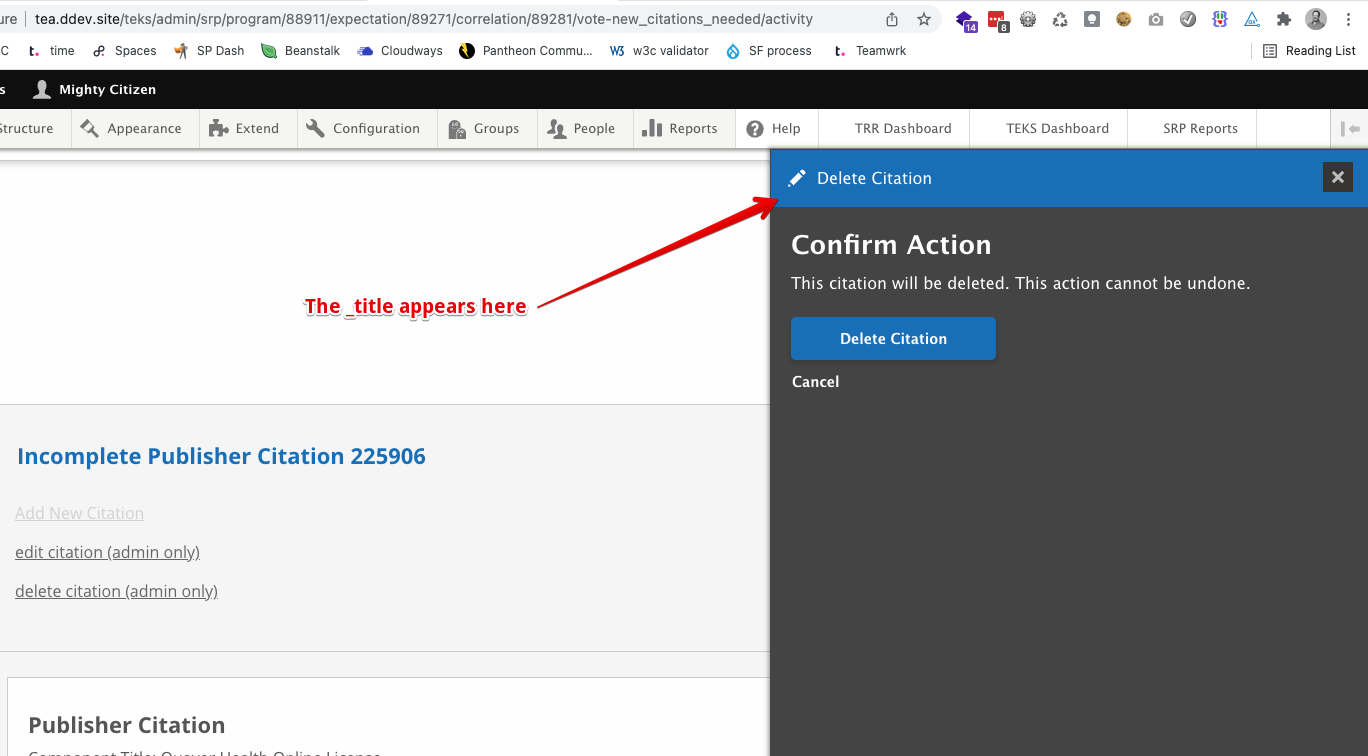
Links to slide-in dialogs
In your controller (or in a form) you can define links in your render array which can fire off the slide-in dialogs. E.g.
use Drupal\Component\Serialization\Json;
$submit_for_review_link = [
'#type' => 'link',
'#title' => t('Submit for Review'),
'#url' => Url::fromRoute('taa_teks_publisher.submit_for_review', ['node' => $node->id(), 'return_type' => 'program']),
'#attributes' => [
'class' => ['use-ajax', 'button'],
'id' => 'edit-program-' . $node->id(),
'data-dialog-renderer' => 'off_canvas',
'data-dialog-type' => 'dialog',
'data-dialog-options' => Json::encode(
[
'width' => '600',
]
),
],
];Notice the data-dialog- options. 'off_canvas' is the magic sauce. Also note that the parameters that are passed to the form are 'node' and 'return_type' which are specified in the route below also.
Note the class 'button' will make this link show up as a button. If you remove it, this will instead just be a link.
You could easily make this a modal dialog by specifying:
'data-dialog-type' => 'modal',
'data-dialog-options' => Json::encode([ 'width' => 'auto',]),Modal dialog example
This example displays a page with links to pop up two different modal dialogs. Clicking on either of the links will display a slightly different modal dialogs. The page looks like this: 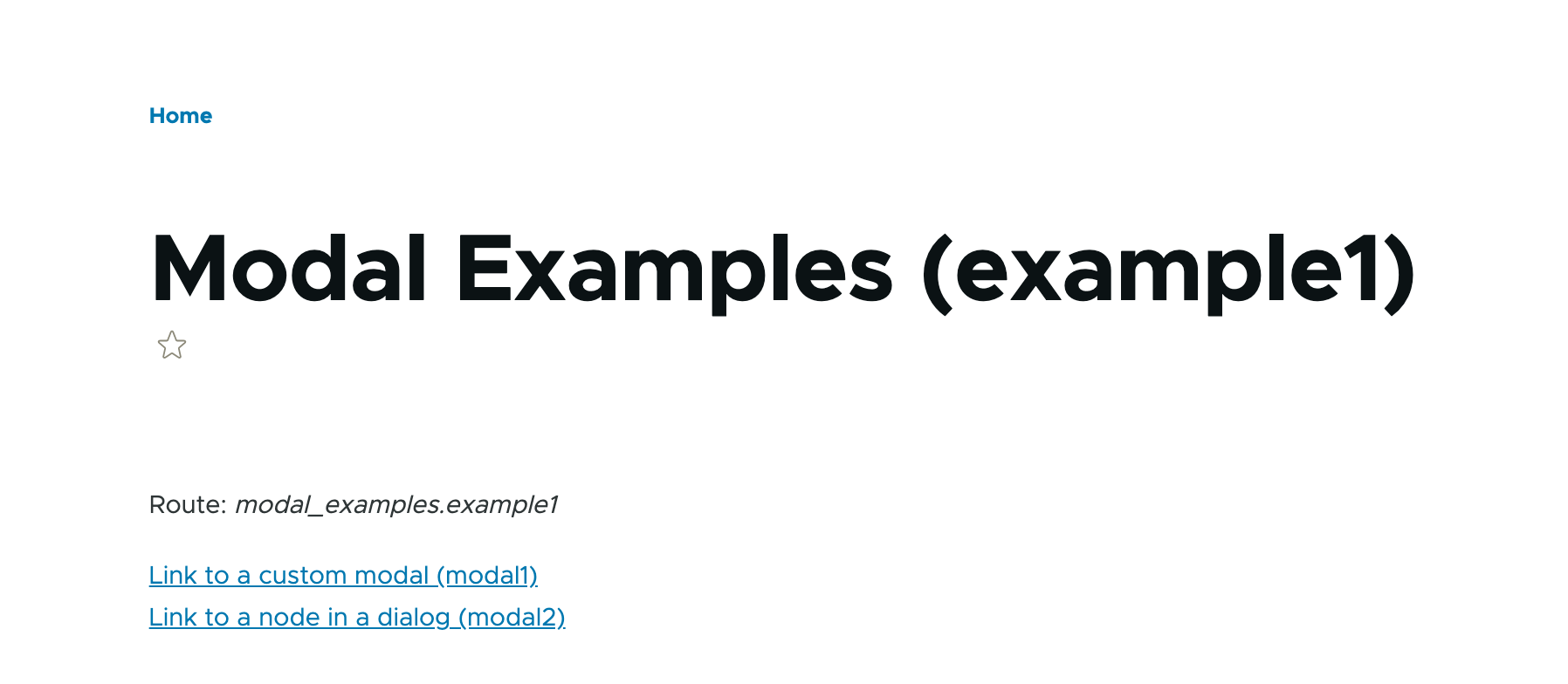
Here is the routing file at web/modules/custom/modal_examples/modal_examples.routing.yml.
The first route (modal_examples.example1) displays the links. The second route (modal_examples.modal1) allows the modal be displayed on a page on its own. This route also has parameters which can be useful when you want to display some relevant variable information in the dialog.
# Controller with buttons to open modals
modal_examples.example1:
path: '/modal-examples/example1'
defaults:
_title: 'Modal Examples (example1)'
_controller: '\Drupal\modal_examples\Controller\ModalExamplesController::buildExample1'
requirements:
_permission: 'access content'
# first modal
modal_examples.modal1:
path: '/modal-examples/modal1/{program_id}/{type}'
defaults:
_title: 'Modal 1 with parameters'
_controller: '\Drupal\modal_examples\Controller\ModalExamplesController::buildModal1'
requirements:
_permission: 'access content'
options:
parameters:
program_id:
type:
no_cache: 'TRUE'
# Second modal
# You can't use this route directly
# route for modal to display a teaser of a node in a dialog
modal_examples.modal2:
path: '/modal-examples/create-my-dialog'
defaults:
_controller: '\Drupal\modal_examples\Controller\ModalExamplesController2::createDialogFromNode'
requirements:
_access: 'TRUE'In web/modules/custom/modal_examples/src/Controller/ModalExamplesController.php are the functions for both the page (which displays the link) and first modal.
Add the parameters to the end of the Url::fromRoute() call to pass them to the modal. You will probably do this a lot.
'#url' => Url::fromRoute('modal_examples.modal1', [
'program_id' => 123,
'type' => 'all',
]),<?php
namespace Drupal\modal_examples\Controller;
use Drupal\Component\Serialization\Json;
use Drupal\Core\Controller\ControllerBase;
use Drupal\Core\Url;
/**
* Returns responses for Modal Examples routes.
*/
class ModalExamplesController extends ControllerBase {
public function buildExample1() {
$route_name = \Drupal::routeMatch()->getRouteName();
$build['content'] = [
'#type' => 'item',
'#markup' => $this->t('Route: %route', ['%route' => $route_name]),
];
$build['link-to-modal1'] = [
'#type' => 'link',
'#title' => t('Link to a custom modal (modal1)'),
'#url' => Url::fromRoute('modal_examples.modal1', [
'program_id' => 123,
'type' => 'all',
]),
'#attributes' => [
'id' => 'view-correlation-' . 12345,
'class' => ['use-ajax'],
'aria-label' => 'View useful information pertaining to item ' . '12345',
'#prefix' => '<div class="abcdef">',
'#suffix' => '</div>',
'data-dialog-type' => 'modal',
'data-dialog-options' => Json::encode(
[
'width' => 'auto',
]
),
],
];
$build['link-to-modal2'] = [
'#type' => 'link',
'#url' => new Url('modal_examples.modal2'),
'#title' => 'Link to a node in a dialog (modal2)',
'#prefix' => '<div class="pqrst">',
'#suffix' => '</div>',
'#attributes' => [
'class' => ['use-ajax'],
],
];
$build['#attached']['library'][] = 'core/drupal.dialog.ajax';
return $build;
}
public function buildModal1(int $program_id, string $type) {
$build['content'] = [
'#type' => 'item',
'#markup' => $this->t('Some useful information!'),
];
$build['other_content'] = [
'#type' => 'item',
'#markup' => $this->t('Program id: @program_id. Type: @type', [
'@program_id' => $program_id,
'@type' => $type,
]),
];
return $build;
}
}The second modal is in ModalExamplesController2.php. This dialog uses the example from an example at https://www.hashbangcode.com/article/drupal-9-creating-ajax-dialogs which displays a teaser view of a node:
<?php
/**
* @file
*
* Contains \Drupal\modal_examples\Controller\ModalExamplesController2.
*/
namespace Drupal\modal_examples\Controller;
use Drupal\Core\Ajax\OpenDialogCommand;
use Drupal\Core\Entity\EntityTypeManagerInterface;
use Symfony\Component\DependencyInjection\ContainerInterface;
use Drupal\Core\Ajax\AjaxResponse;
use Drupal\Core\Ajax\OpenModalDialogCommand;
use Drupal\Core\Controller\ControllerBase;
use Drupal\Core\Form\FormBuilder;
/**
* ModalExamplesController2 class.
*/
class ModalExamplesController2 extends ControllerBase {
/**
* The form builder.
*
* @var \Drupal\Core\Form\FormBuilder
*/
protected $formBuilder;
/**
* The entity type manager.
*
* @var \Drupal\Core\Entity\EntityTypeManagerInterface
*/
protected $entityTypeManager;
/**
* The ModalFormExampleController constructor.
*
* @param \Drupal\Core\Form\FormBuilder $formBuilder
* The form builder.
* @param \Drupal\Core\Entity\EntityTypeManagerInterface $entity_type_manager
* The entity type manager.
*/
public function __construct(FormBuilder $formBuilder, EntityTypeManagerInterface $entity_type_manager) {
$this->formBuilder = $formBuilder;
$this->entityTypeManager = $entity_type_manager;
}
/**
* {@inheritdoc}
*
* @param \Symfony\Component\DependencyInjection\ContainerInterface $container
* The Drupal service container.
*
* @return static
*/
public static function create(ContainerInterface $container) {
return new static(
$container->get('form_builder'),
$container->get('entity_type.manager'),
);
}
/*
* Phil's open a dialog to display a node teaser.
*/
public function createDialogFromNode() {
// Load a specific node.
$node = $this->entityTypeManager->getStorage('node')->load(34);
// Convert node into a render array.
$viewBuilder = $this->entityTypeManager->getViewBuilder('node');
$content = $viewBuilder->view($node, 'teaser');
// Get the title of the node.
$title = $node->getTitle();
// Create the AjaxResponse object.
$response = new AjaxResponse();
// Attach the library needed to use the OpenDialogCommand response.
$attachments['library'][] = 'core/drupal.dialog.ajax';
$response->setAttachments($attachments);
// Add the open dialog command to the ajax response.
$response->addCommand(new OpenDialogCommand('#my-dialog-selector', $title, $content, ['width' => '70%']));
return $response;
}
}Here is the first modal dialog as it appears on the site when the modal1 link is clicked:
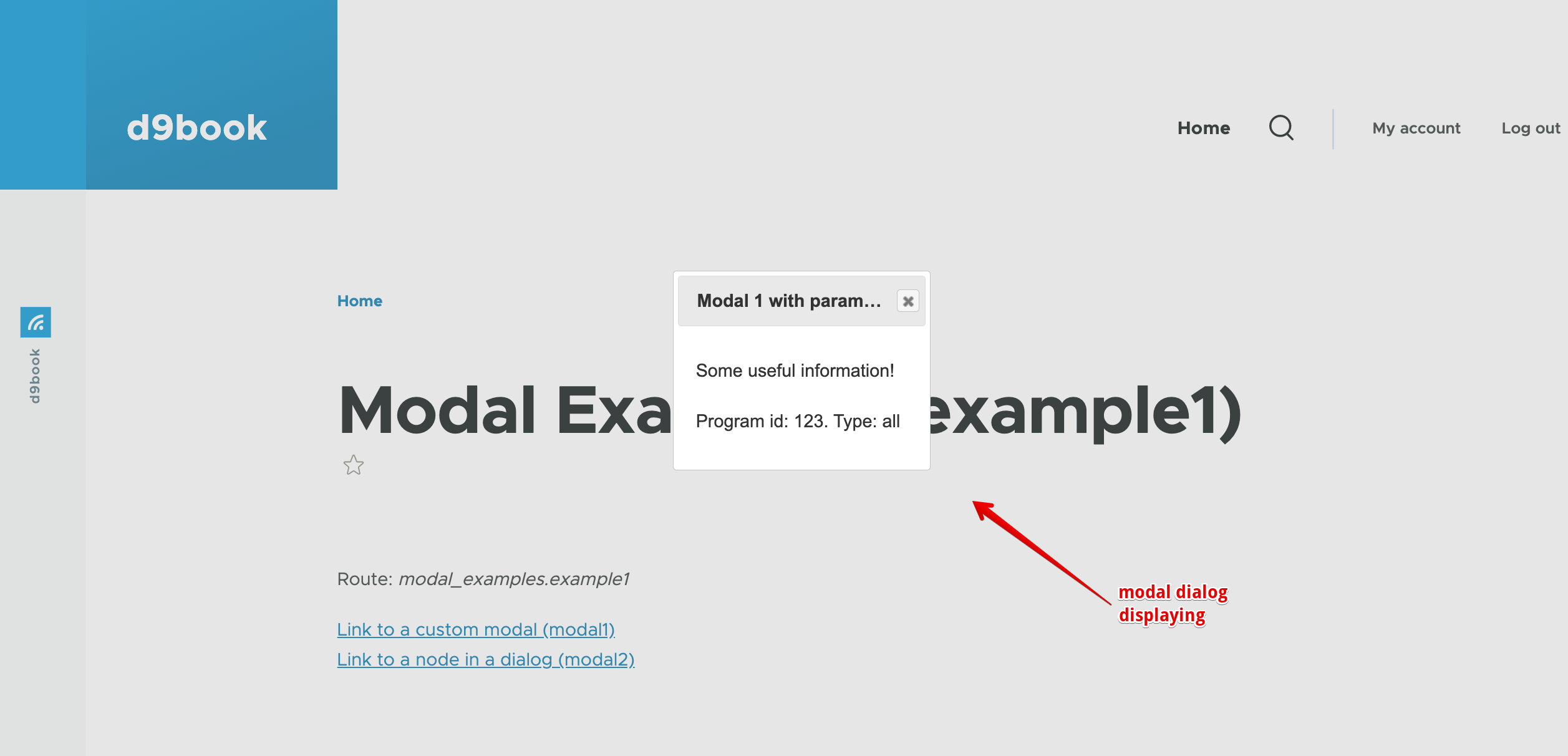
And the second
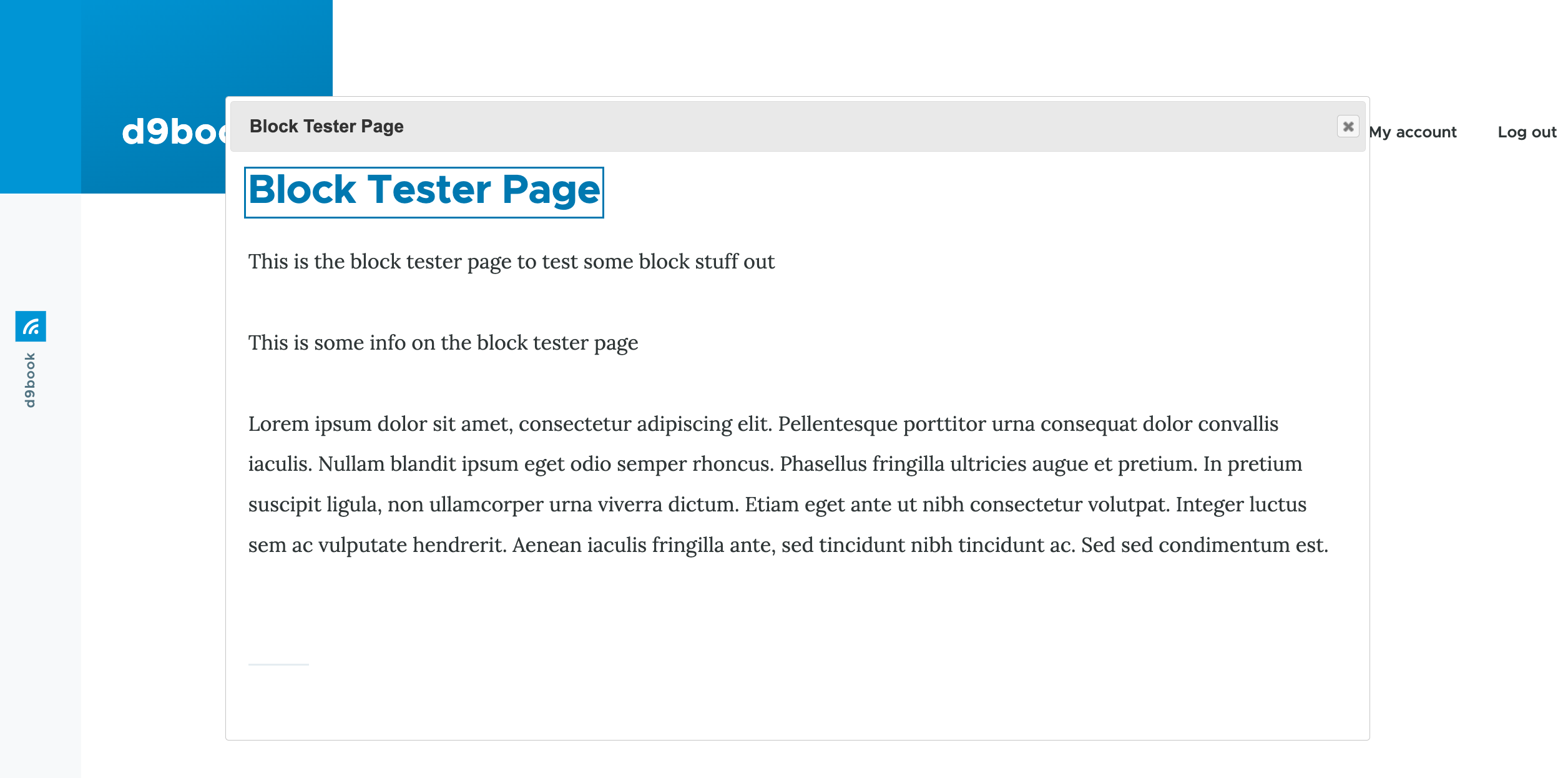
Passing entities as parameters
Sometimes it is useful to pass a node as a parameter so you can quickly grab fields from it. To do this, specify type: entity: node (or other type of entity) in the *.routing.yml file. See the example below where parameters: program and correlation are identified as nodes. In your code, you pass the node id (not the entire node) and Drupal will automatically load the node for you and pass it to the controller:
taa.view_votes:
path: '/srp/program/{program}/vote-view/correlation/{correlation}/{type}'
defaults:
_controller: '\Drupal\taa\Controller\ViewVotesController::content'
_title: 'Votes for Citation'
requirements:
_permission: 'view any saa item+view own saa item'
options:
parameters:
program:
type: entity:node
correlation:
type: entity:node
no_cache: 'TRUE'The controller will look like this. Notice how we can call entity functions on the $program and $correlation entities.
public function content(EntityInterface $program, EntityInterface $correlation, string $type = 'all'): array {
$program_nid = $program->id();
$correlation_nid = $correlation->id();
$vote_number = $program->get('field_srp_vote_number')->value;Modal form example
This example displays a form with a button. When a user presses the button, a dialog containing another form appears.
This code is a little convoluted as the link you click to open the modal form calls a controller function, ModalExamplesController2::openModalForm(), which loads the form and opens it with an ajax command, OpenModalDialogCommand. You can directly point a link to a form route (as you can find in other examples below.)
Also notice that controller uses dependency injection to load the form builder (which is the recommended way to do things.).
In web/modules/custom/modal_examples/modal_examples.routing.yml we first set up a route for the form which will be initially displayed. This is identified as modal_examples.form1.
Secondly, we set up a route for the popup form, modal_examples.modal_form.
modal_examples.form1:
path: '/modal-examples/form1'
defaults:
_form: 'Drupal\modal_examples\Form\ExampleForm'
_title: 'Form with a button to popup a modal form'
requirements:
_permission: 'administer site configuration'
modal_examples.modal_form:
path: '/modal-examples/modal_form'
defaults:
_title: 'The Modal Form'
_controller: '\Drupal\modal_examples\Controller\ModalExamplesController2::openModalForm'
requirements:
_permission: 'administer site configuration'
options:
_admin_route: TRUEWhen we navigate to /modal-example/form, we see the following form. If we click the button labelled, "Click to see the Modal Form", a modal dialog will appear with a form in it.
Here is the initial form:
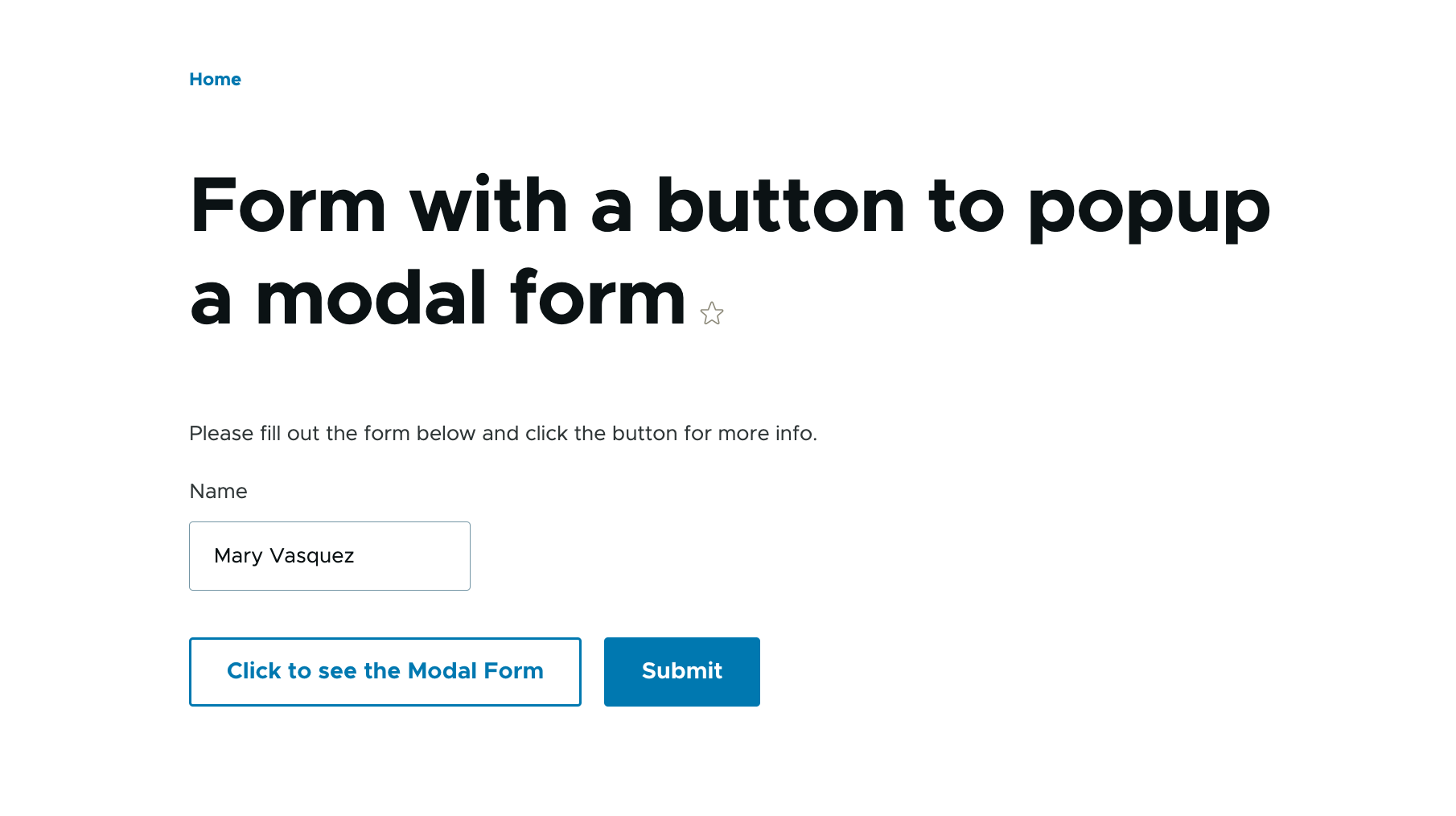
And here is the modal popped up over it:
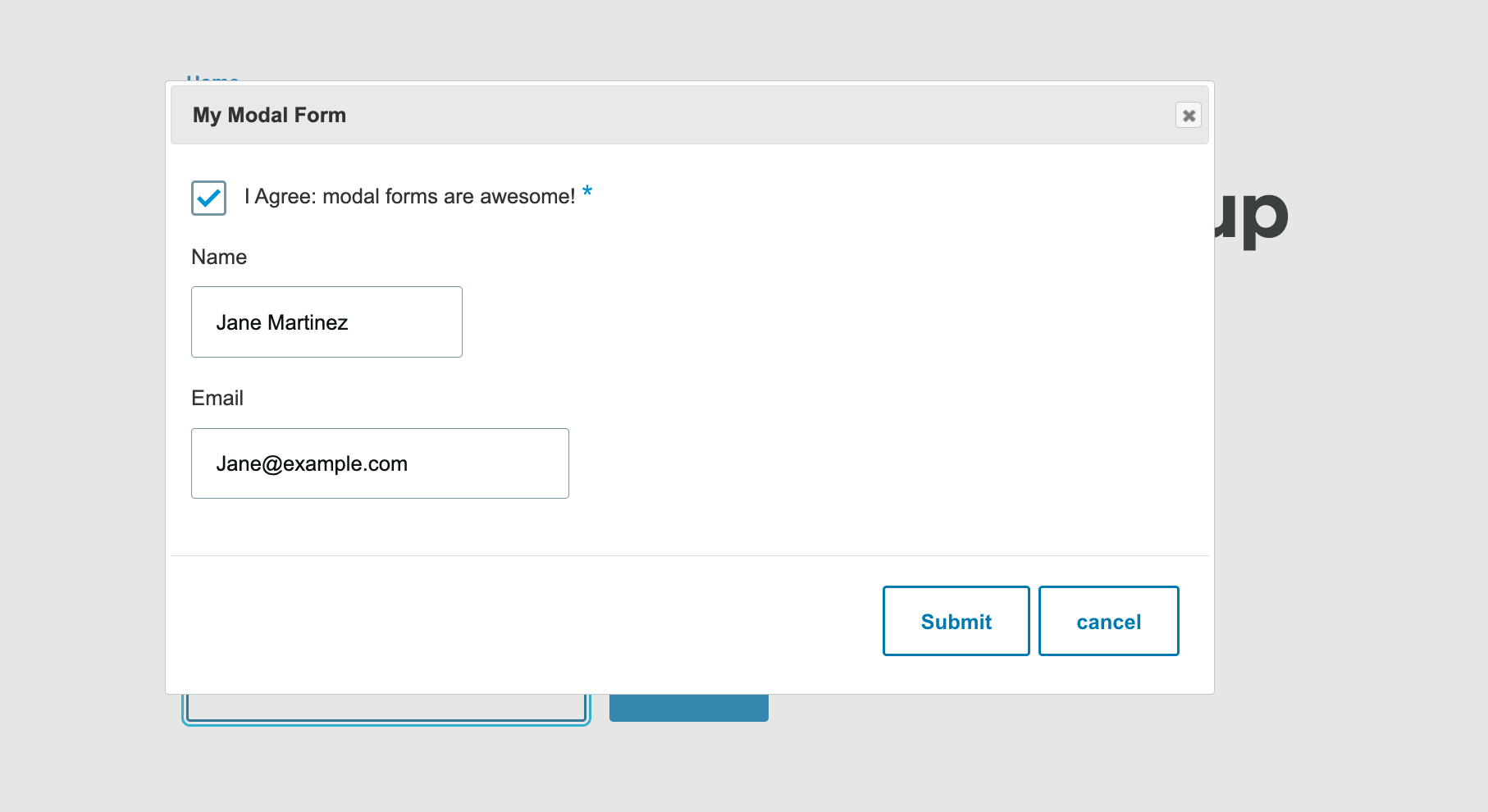
Here is the code for the first form in web/modules/custom/modal_examples/src/Form/ExampleForm.php. Notice the link at $form['actions']['open_modal'] which is used to invoke the modal form. Note. It is essential that you specify the use-ajax class for this link.
<?php
namespace Drupal\modal_examples\Form;
use Drupal\Core\Form\FormBase;
use Drupal\Core\Form\FormStateInterface;
use Drupal\Core\Url;
/**
* ExampleForm class.
*/
class ExampleForm extends FormBase {
/**
* {@inheritdoc}
*/
public function buildForm(array $form, FormStateInterface $form_state, $options = NULL) {
$form['#prefix'] = '<div id="example_form">';
$form['#suffix'] = '</div>';
$form['info']['instructions'] = [
'#type' => 'markup',
'#markup' => $this->t('Please fill out the form below and click the button for more info.'),
];
$form['info']['name'] = [
'#type' => 'textfield',
'#title' => $this->t('Name'),
'#size' => 20,
'#default_value' => 'Mary Vasquez',
'#required' => FALSE,
];
$form['actions']['open_modal'] = [
'#type' => 'link',
'#title' => $this->t('Click to see the Modal Form'),
'#url' => Url::fromRoute('modal_examples.modal_form'),
'#attributes' => [
'class' => [
'use-ajax',
'button',
],
],
];
$form['actions']['submit'] = [
'#type' => 'submit',
'#value' => $this->t('Submit'),
'#attributes' => [
],
];
return $form;
}
/**
* {@inheritdoc}
*/
public function submitForm(array &$form, FormStateInterface $form_state) {
// @TODO.
}
/**
* {@inheritdoc}
*/
public function getFormId() {
return 'modal_examples_example_form';
}
}Here is the controller that is used to load the modal form at web/modules/custom/modal_examples/src/Controller/ModalExamplesController2.php
<?php
/**
* @file
*
* Contains \Drupal\modal_examples\Controller\ModalExamplesController2.
*/
namespace Drupal\modal_examples\Controller;
use Symfony\Component\DependencyInjection\ContainerInterface;
use Drupal\Core\Ajax\AjaxResponse;
use Drupal\Core\Ajax\OpenModalDialogCommand;
use Drupal\Core\Controller\ControllerBase;
use Drupal\Core\Form\FormBuilder;
/**
* ModalExamplesController2 class.
*/
class ModalExamplesController2 extends ControllerBase {
/**
* The form builder.
*
* @var \Drupal\Core\Form\FormBuilder
*/
protected $formBuilder;
/**
* The ModalFormExampleController constructor.
*
* @param \Drupal\Core\Form\FormBuilder $formBuilder
* The form builder.
*/
public function __construct(FormBuilder $formBuilder) {
$this->formBuilder = $formBuilder;
}
/**
* {@inheritdoc}
*
* @param \Symfony\Component\DependencyInjection\ContainerInterface $container
* The Drupal service container.
*
* @return static
*/
public static function create(ContainerInterface $container) {
return new static(
$container->get('form_builder')
);
}
/**
* Callback for opening the modal form.
*/
public function openModalForm() {
$response = new AjaxResponse();
// Get the modal form using the form builder.
$modal_form = $this->formBuilder->getForm('Drupal\modal_examples\Form\ExampleModalForm');
// Add an AJAX command to open a modal dialog with the form as the content.
$response->addCommand(new OpenModalDialogCommand('My Modal Form', $modal_form, ['width' => '800']));
return $response;
}
}And finally, here is the "modal" form itself at web/modules/custom/modal_examples/src/Form/ExampleModalForm.php
<?php
namespace Drupal\modal_examples\Form;
use Drupal\Core\Ajax\CloseModalDialogCommand;
use Drupal\Core\Form\FormBase;
use Drupal\Core\Form\FormStateInterface;
use Drupal\Core\Ajax\AjaxResponse;
use Drupal\Core\Ajax\OpenModalDialogCommand;
use Drupal\Core\Ajax\ReplaceCommand;
/**
* ModalForm class.
*/
class ExampleModalForm extends FormBase {
/**
* {@inheritdoc}
*/
public function getFormId() {
return 'modal_form_example_modal_form';
}
/**
* {@inheritdoc}
*/
public function buildForm(array $form, FormStateInterface $form_state, $options = NULL) {
$form['#prefix'] = '<div id="modal_example_form">';
$form['#suffix'] = '</div>';
// The status messages that will contain any form errors.
$form['status_messages'] = [
'#type' => 'status_messages',
'#weight' => -10,
];
// A required checkbox field.
$form['our_checkbox'] = [
'#type' => 'checkbox',
'#title' => $this->t('I Agree: modal forms are awesome!'),
'#default_value' => TRUE,
'#required' => TRUE,
];
$form['name'] = [
'#type' => 'textfield',
'#title' => $this->t('Name'),
'#size' => 20,
'#default_value' => 'Jane Martinez',
'#required' => FALSE,
];
$form['email'] = [
'#type' => 'email',
'#title' => $this->t('Email'),
'#size' => 30,
'#default_value' => 'Jane@example.com',
'#required' => FALSE,
];
$form['actions'] = array('#type' => 'actions');
$form['actions']['send'] = [
'#type' => 'submit',
'#value' => $this->t('Submit'),
'#attributes' => [
'class' => [
'use-ajax',
],
],
'#ajax' => [
'callback' => [$this, 'submitModalFormAjax'],
'event' => 'click',
],
];
$form['actions']['cancel'] = [
'#type' => 'submit',
'#value' => $this->t('cancel'),
'#attributes' => [
'class' => [
'use-ajax',
],
],
'#ajax' => [
'callback' => [$this, 'closeModalForm'],
'event' => 'click',
],
];
$form['#attached']['library'][] = 'core/drupal.dialog.ajax';
return $form;
}
/**
* AJAX callback handler that displays any errors or a success message.
*/
public function submitModalFormAjax(array $form, FormStateInterface $form_state) {
$response = new AjaxResponse();
// If there are any form errors, re-display the form.
if ($form_state->hasAnyErrors()) {
$response->addCommand(new ReplaceCommand('#modal_example_form', $form));
}
else {
//Close the modal.
$command = new CloseModalDialogCommand();
$response->addCommand($command);
// Pop up a new modal with a title success etc.
$response->addCommand(new OpenModalDialogCommand("Success!", 'The modal form has been submitted.', ['width' => 800]));
}
return $response;
}
/**
* @return \Drupal\Core\Ajax\AjaxResponse
*/
public function closeModalForm() {
$command = new CloseModalDialogCommand();
$response = new AjaxResponse();
$response->addCommand($command);
// $response->addCommand(new OpenModalDialogCommand("Cancel!", 'Why did you cancel me?', ['width' => 400]));
return $response;
}
/**
* {@inheritdoc}
*/
public function validateForm(array &$form, FormStateInterface $form_state) {
// @TODO.
}
/**
* {@inheritdoc}
*/
public function submitForm(array &$form, FormStateInterface $form_state) {
// @TODO.
}
}Slide-in dialog/Off-canvas dialog
Slide in dialogs are modals that appear to slide-in from the right side or top of the screen. Like any modal dialogs they can contain forms
Slide-in Dialog Example
This example shows 4 different types of links which fire off variations of slide-in dialogs. Check out the links below:
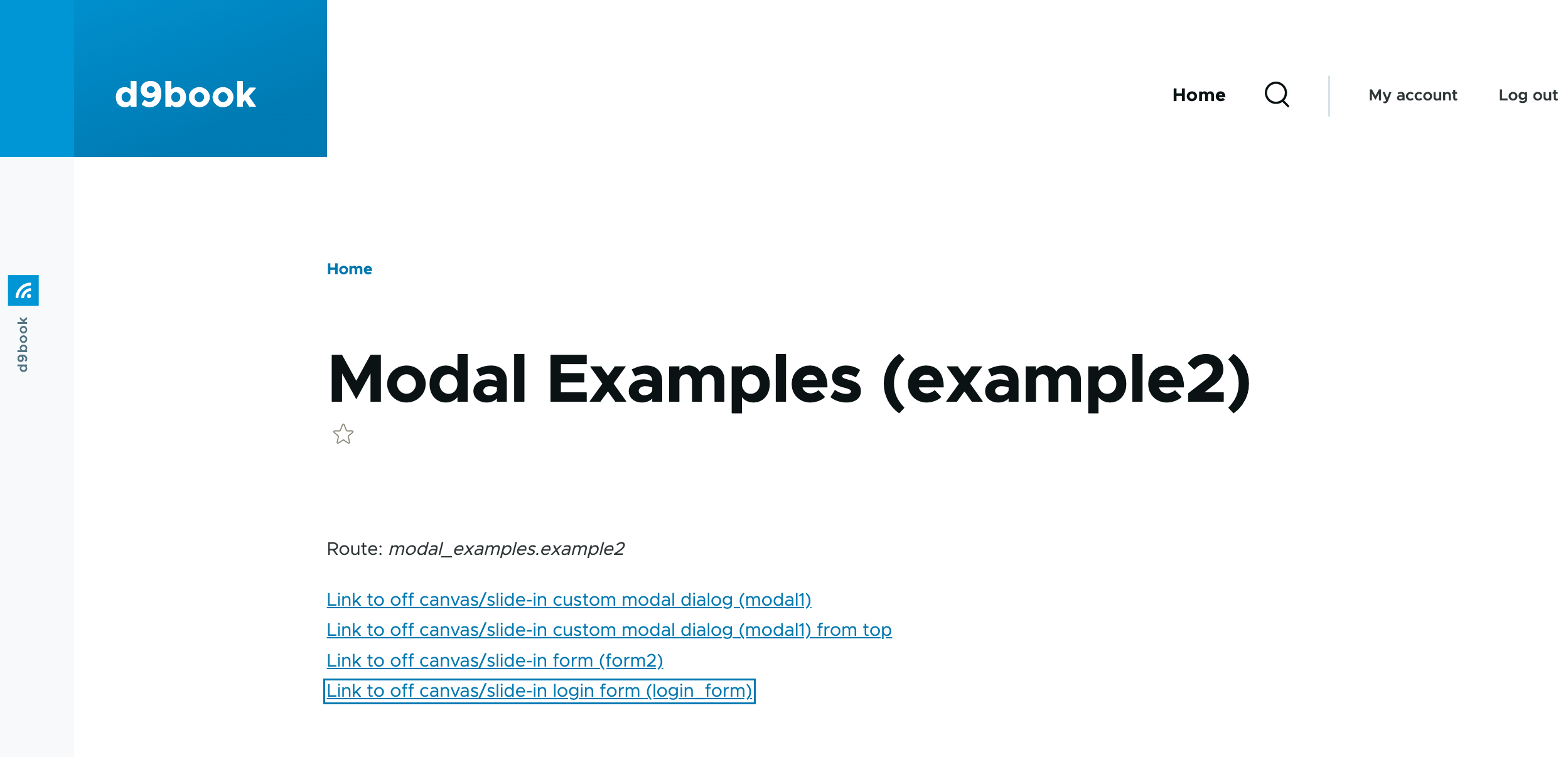
In web/modules/custom/modal_examples/modal_examples.routing.yml we specify the routes for our controller, example2 as well as modal1, form2 and login_form:
# Controller with buttons to open modals
modal_examples.example2:
path: '/modal-examples/example2'
defaults:
_title: 'Modal Examples (example2)'
_controller: '\Drupal\modal_examples\Controller\ModalExamplesController2::buildExample2'
requirements:
_permission: 'access content'
# modal1
modal_examples.modal1:
path: '/modal-examples/modal1/{program_id}/{type}'
defaults:
_title: 'Modal 1 with parameters'
_controller: '\Drupal\modal_examples\Controller\ModalExamplesController::buildModal1'
requirements:
_permission: 'access content'
options:
parameters:
program_id:
type:
no_cache: 'TRUE'
# Simple form for slide-in modals
modal_examples.form2:
path: '/modal-examples/form2'
defaults:
_form: 'Drupal\modal_examples\Form\ExampleForm2'
_title: 'Simple example form (form2)'
requirements:
_permission: 'access content'
# Form with buttons to open modals
modal_examples.login_form:
path: '/modal-examples/login-form'
defaults:
_title: 'Simple example form (form2)'
_controller: 'Drupal\modal_examples\Controller\ModalExamplesController2::buildLoginForm'
requirements:
_permission: 'access content'Here is the controller for example2, web/modules/custom/modal_examples/src/Controller/ModalExamplesController2.php. You will find the functions buildExample2() which creates the 4 links and buildLoginForm() which uses Drupal's formbuilder to build the login form.
<?php
/**
* @file
*
* Contains \Drupal\modal_examples\Controller\ModalExamplesController2.
*/
namespace Drupal\modal_examples\Controller;
use Drupal\Component\Serialization\Json;
use Drupal\Core\Ajax\OpenDialogCommand;
use Drupal\Core\Entity\EntityTypeManagerInterface;
use Drupal\Core\Url;
use Symfony\Component\DependencyInjection\ContainerInterface;
use Drupal\Core\Ajax\AjaxResponse;
use Drupal\Core\Ajax\OpenModalDialogCommand;
use Drupal\Core\Controller\ControllerBase;
use Drupal\Core\Form\FormBuilder;
/**
* ModalExamplesController2 class.
*/
class ModalExamplesController2 extends ControllerBase {
/**
* The form builder.
*
* @var \Drupal\Core\Form\FormBuilder
*/
protected $formBuilder;
/**
* The entity type manager.
*
* @var \Drupal\Core\Entity\EntityTypeManagerInterface
*/
protected $entityTypeManager;
/**
* The ModalFormExampleController constructor.
*
* @param \Drupal\Core\Form\FormBuilder $formBuilder
* The form builder.
* @param \Drupal\Core\Entity\EntityTypeManagerInterface $entity_type_manager
* The entity type manager.
*/
public function __construct(FormBuilder $formBuilder, EntityTypeManagerInterface $entity_type_manager) {
$this->formBuilder = $formBuilder;
$this->entityTypeManager = $entity_type_manager;
}
/**
* {@inheritdoc}
*
* @param \Symfony\Component\DependencyInjection\ContainerInterface $container
* The Drupal service container.
*
* @return static
*/
public static function create(ContainerInterface $container) {
return new static(
$container->get('form_builder'),
$container->get('entity_type.manager'),
);
}
public function buildExample2() {
$route_name = \Drupal::routeMatch()->getRouteName();
$build['content'] = [
'#type' => 'item',
'#markup' => $this->t('Route: %route', ['%route' => $route_name]),
];
$build['link-to-modal1'] = [
'#type' => 'link',
'#prefix' => '<div class="pqrst">',
'#suffix' => '</div>',
'#title' => t('Link to off canvas/slide-in custom modal dialog (modal1)'),
'#url' => Url::fromRoute('modal_examples.modal1', [
'program_id' => 123,
'type' => 'all',
]),
'#attributes' => [
'id' => 'view-correlation-' . 12345,
'class' => ['use-ajax'],
'aria-label' => 'View useful information pertaining to item ' . '12345',
'#prefix' => '<div class="abcdef">',
'#suffix' => '</div>',
'data-dialog-type' => 'dialog.off_canvas',
'data-dialog-options' => Json::encode(
[
'width' => 'auto',
]
),
],
];
$build['link-to-modal1-top'] = [
'#type' => 'link',
'#prefix' => '<div class="pqrst">',
'#suffix' => '</div>',
'#title' => t('Link to off canvas/slide-in custom modal dialog (modal1) from top'),
'#url' => Url::fromRoute('modal_examples.modal1', [
'program_id' => 123,
'type' => 'all',
]),
'#attributes' => [
'id' => 'view-correlation-' . 12345,
'class' => ['use-ajax'],
'aria-label' => 'View useful information pertaining to item ' . '12345',
'#prefix' => '<div class="abcdef">',
'#suffix' => '</div>',
'data-dialog-type' => 'dialog.off_canvas_top',
'data-dialog-options' => Json::encode(
[
'width' => 'auto',
]
),
],
];
$build['link-to-example2-form'] = [
'#type' => 'link',
'#prefix' => '<div class="pqrst">',
'#suffix' => '</div>',
'#title'=> t('Link to off canvas/slide-in form (form2) '),
'#url' => Url::fromRoute('modal_examples.form2', [
'program_id' => 123,
'type' => 'all',
]),
'#attributes' => [
'id' => 'important-id-' . 12345,
'class' => ['use-ajax'],
'#prefix' => '<div class="abcdef">',
'#suffix' => '</div>',
'data-dialog-type' => 'dialog.off_canvas',
'data-dialog-options' => Json::encode(
[
'width' => 'auto',
]
),
],
];
$build['link-to-example-login-form'] = [
'#type' => 'link',
'#prefix' => '<div class="pqrst">',
'#suffix' => '</div>',
'#title'=> t('Link to off canvas/slide-in login form (login_form) '),
'#url' => Url::fromRoute('modal_examples.login_form'),
'#attributes' => [
'id' => 'important-id-' . 12345,
'class' => ['use-ajax'],
'#prefix' => '<div class="abcdef">',
'#suffix' => '</div>',
'data-dialog-type' => 'dialog.off_canvas',
'data-dialog-options' => Json::encode(
[
'width' => 'auto',
]
),
],
];
$build['#attached']['library'][] = 'core/drupal.dialog.ajax';
$build['#attached']['library'][] = 'core/drupal.dialog.off_canvas';
return $build;
}
public function buildLoginForm() {
//$form = \Drupal::formBuilder()->getForm(\Drupal\user\Form\UserLoginForm::class);
$form = $this->formBuilder()->getForm(\Drupal\user\Form\UserLoginForm::class);
return $form;
}
}BuildModal1() is in ModalExamplesController.php (above):
public function buildModal1(int $program_id, string $type) {
$build['content'] = [
'#type' => 'item',
'#markup' => $this->t('Some useful information!'),
];
$build['other_content'] = [
'#type' => 'item',
'#markup' => $this->t('Program id: @program_id. Type: @type', [
'@program_id' => $program_id,
'@type' => $type,
]),
];
return $build;
}This is what to expect when you click the first link:
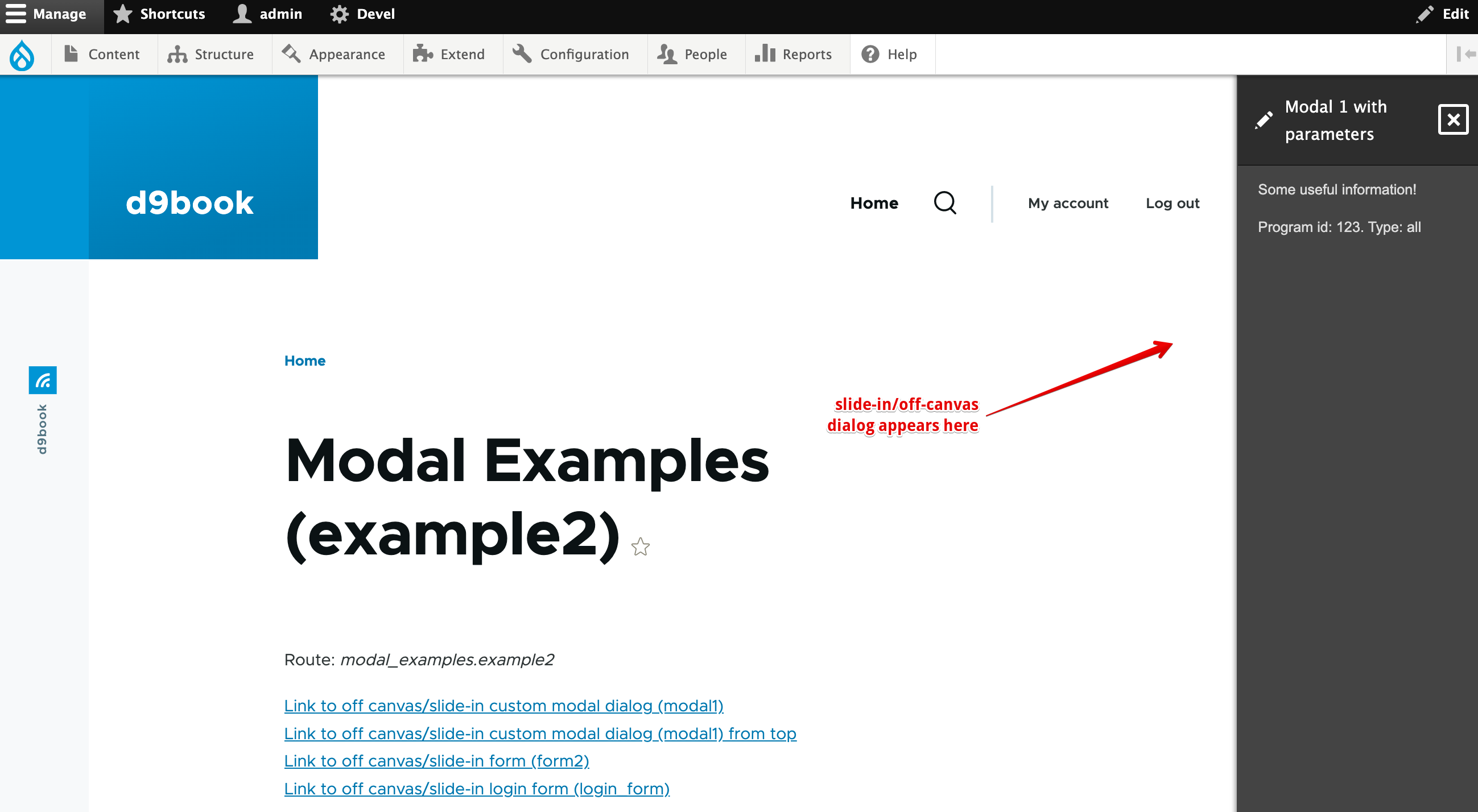
And the second which shows the dialog sliding in from the top:
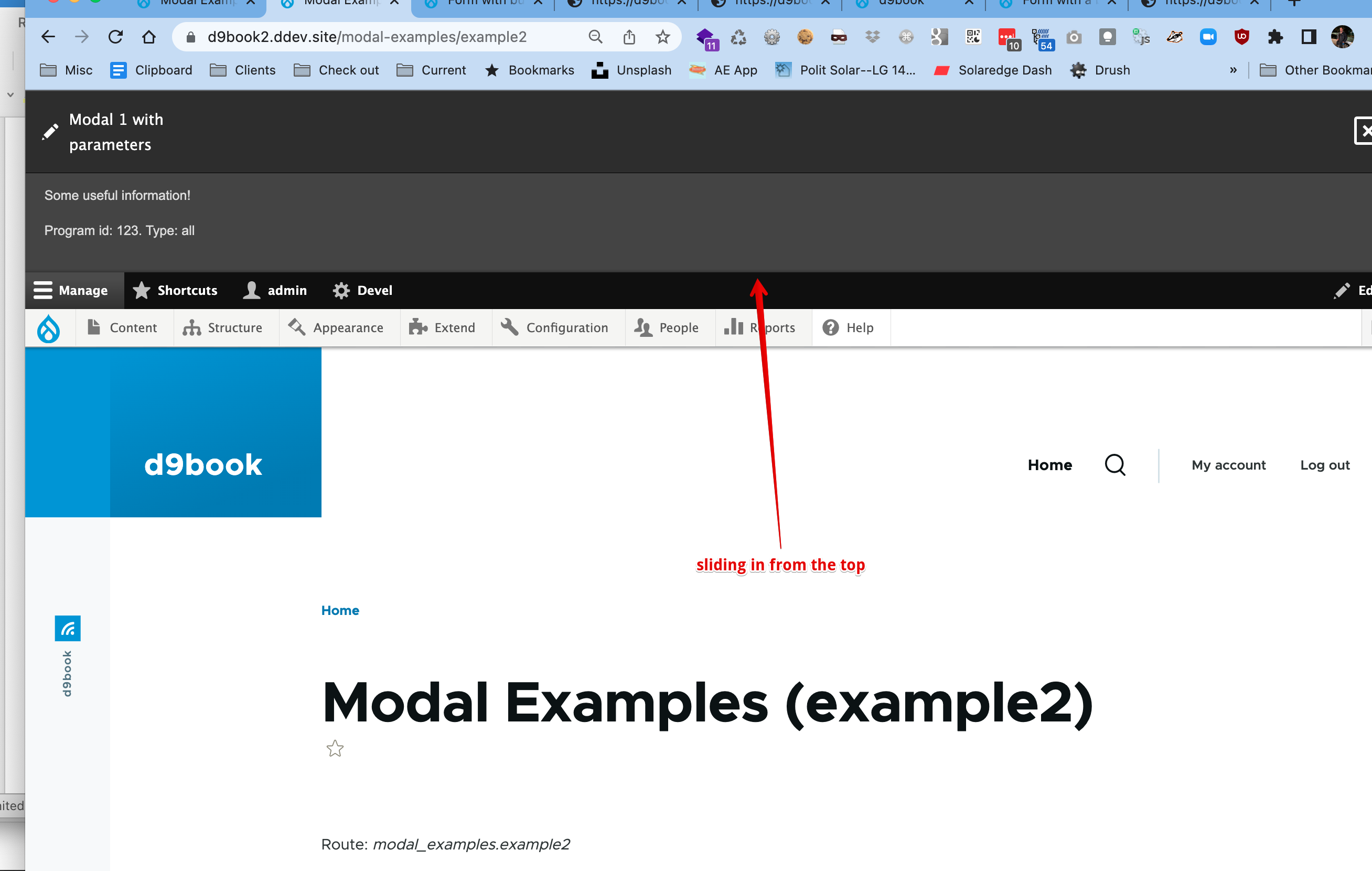
Here is our custom form sliding in:
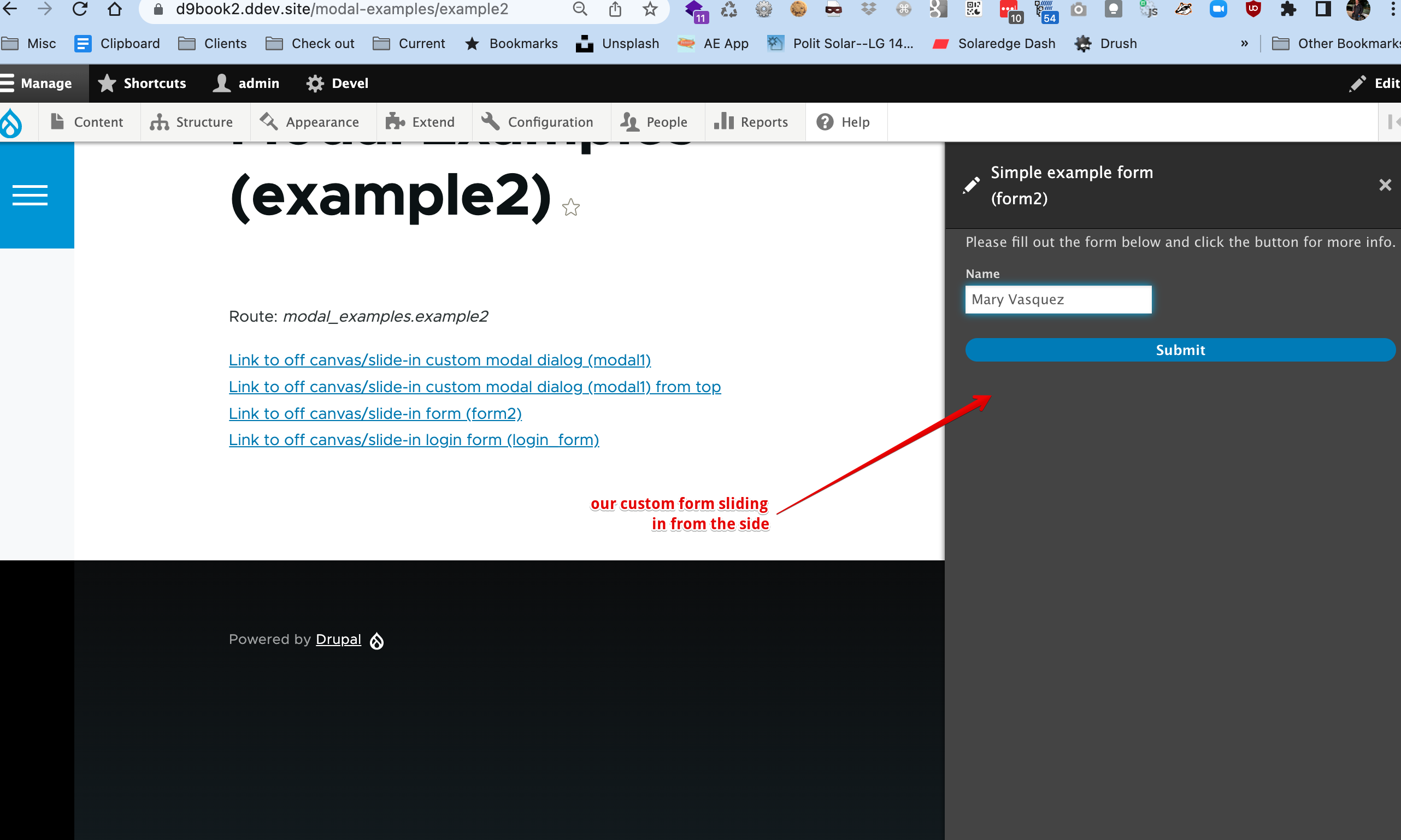
And finally the login form sliding in:
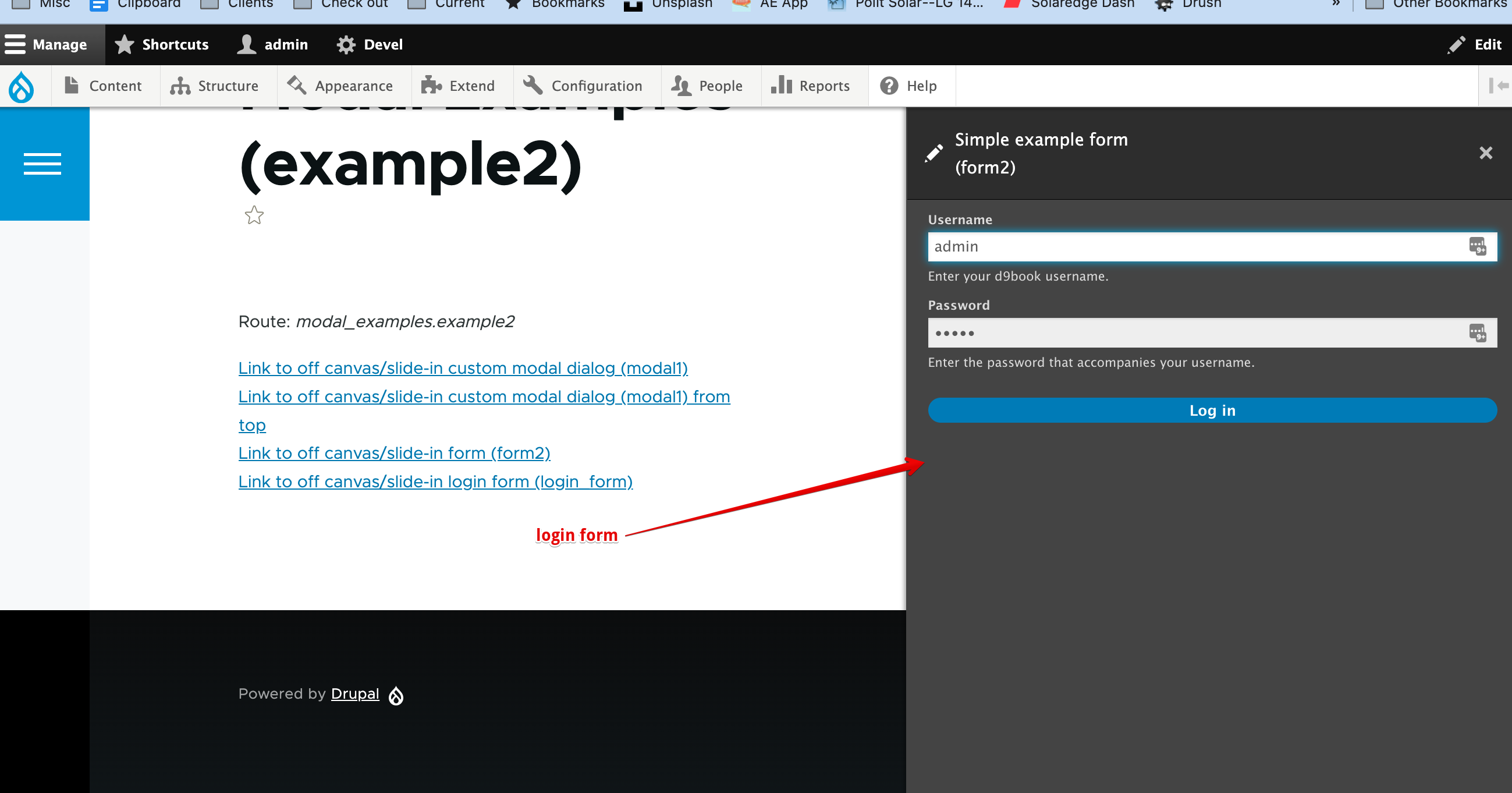
Block with a link to popup a custom modal dialog
This is an example from http://befused.com/drupal/modal-module
In the module custom_modal, there is a custom_modal.routing.yml which specifies the route and controller.
custom_modal.modal:
path: 'modal-example/modal'
defaults:
_title: 'Modal'
_controller: '\Drupal\custom_modal\Controller\CustomModalController::modal'
requirements:
_permission: 'access content'Here we define a block in ModalBlock.php that will present a button, which when clicked, will bring up a modal dialog. Note in the build() method that we get the route using Url::fromRoute('custom_modal.modal').
/**
* Provides a 'Modal' Block
*
* @Block(
* id = "modal_block",
* admin_label = @Translation("Modal block"),
* )
*/
class ModalBlock extends BlockBase {
/**
* {@inheritdoc}
*/
public function build() {
$link_url = Url::fromRoute('custom_modal.modal');
$link_url->setOptions([
'attributes' => [
'class' => ['use-ajax', 'button', 'button--small'],
'data-dialog-type' => 'modal',
'data-dialog-options' => Json::encode(['width' => 400]),
]
]);
return array(
'#type' => 'markup',
'#markup' => Link::fromTextAndUrl(t('Open modal'), $link_url)->toString(),
'#attached' => ['library' => ['core/drupal.dialog.ajax']]
);
}
}Then in the controller, CustomModalController.php the modal() function builds the dialog using a new AjaxResponse() object.
class CustomModalController extends ControllerBase {
public function modal() {
$options = [
'dialogClass' => 'popup-dialog-class',
'width' => '50%',
];
$response = new AjaxResponse();
$response->addCommand(new OpenModalDialogCommand(t('Modal title'), t('The modal text'), $options));
return $response;
}
}To see this work, place the "modal block" in a region via the u/i, then view a page. When you click the button, a modal dialog will pop up showing "the modal text."
No-code modal dialogs
Modal dialogs are incredibly useful on websites as they allow the user to do something without having to leave the web page they are on. Drupal has a Dialog API in core, which greatly reduces the amount of code you need to write to create a modal dialog. Dialogs in Drupal 8 leverage jQuery UI. This is from an article at http://befused.com/drupal/modal .
This capability puts some awesome power in the hands of site builders.
In a custom block with full HTML enabled use the following HTML.
<p><a class="use-ajax" data-dialog-type="modal" href="/search/node">Search</a></p>Or to make this dialog a little wider. E.g. 800 pixels.
<p><a class="use-ajax" data-dialog-options="{"width":800}" data-dialog-type="modal" href="/search/node">Search</a></p>And to show a node instead of the search dialog (any valid drupal path will do here)
<p><a class="use-ajax" data-dialog-options="{"width":800}" data-dialog-type="modal" href="/node/2">See node 2</a></p>